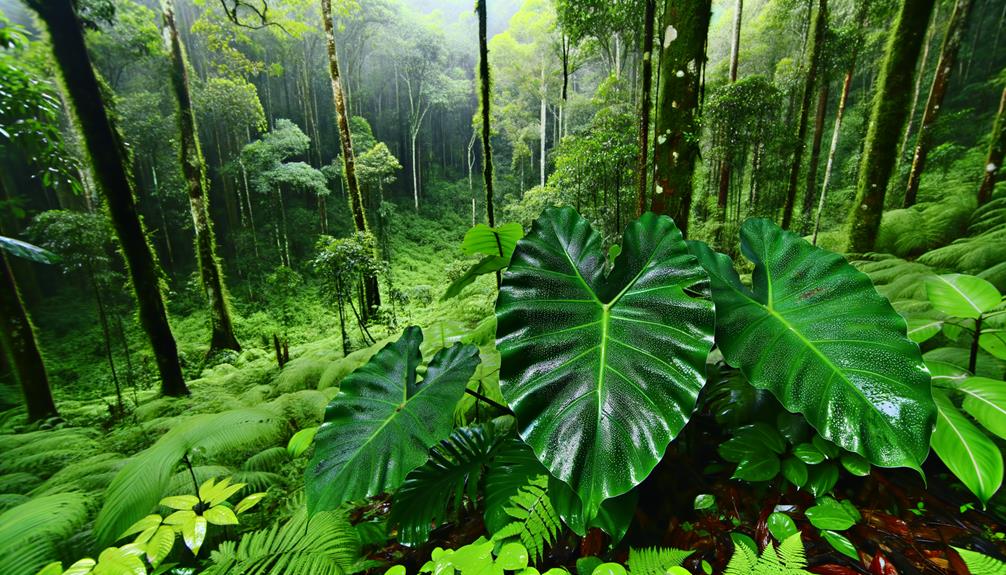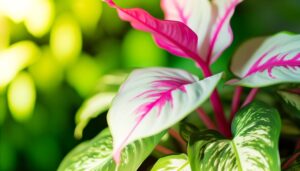What Is the Origin of Philodendron Selloum?
Philodendron selloum, a species within the Araceae family, originates from the humid tropical forests of South America. It thrives under the rainforest canopy in Brazil, Bolivia, Argentina, and Paraguay, favoring high humidity and filtered sunlight.
This plant features large, pinnately divided leaves and a self-supporting growth habit, originally documented by European botanists in the 19th century. Philodendron selloum plays an essential role in its native ecosystem by providing shelter, serving as a food source, and aiding in soil stabilization.
As an adaptable and aesthetically appealing plant, it has gained popularity for both indoor and outdoor cultivation. Continue to uncover its fascinating attributes.

Key Takeaways
- Indigenous to tropical regions of South America, specifically Brazil, Bolivia, Argentina, and Paraguay.
- Thrives in the humid, understory environments of South American rainforests.
- Initially documented by European botanists in the 19th century.
- Adapted to filtered sunlight and high humidity levels of rainforest habitats.
- Collected and systematically documented for its unique morphological features.
Native Habitat

Philodendron selloum, a member of the Araceae family, is indigenous to the tropical regions of South America, particularly thriving in the dense, humid forests of Brazil, Bolivia, Argentina, and Paraguay.
This perennial plant is adapted to the understory of these rainforests, where it benefits from filtered sunlight and high humidity levels. It exhibits robust growth in nutrient-rich, well-drained soils, often found along riverbanks and forest floors.
The plant's large, deeply lobed leaves are designed to maximize photosynthetic efficiency while minimizing water loss. Additionally, P. selloum's aerial roots enable it to anchor and absorb moisture and nutrients from both the soil and the humid air.
These environmental conditions are integral to its growth and propagation in its native habitat.
Historical Discovery
The initial documented encounter with Philodendron selloum dates back to the 19th century when European botanists exploring South America's diverse ecosystems first identified and cataloged the species.
This period marked a pivotal era in botanical exploration, characterized by systematic documentation. Botanists meticulously recorded the plant's morphological features, habitat, and growth patterns.
Collections of live specimens and herbarium samples were transported back to Europe for further study and classification.
Scientific publications followed, with the findings published in botanical journals, contributing to the global scientific community's understanding of tropical flora.
The discovery of Philodendron selloum exemplifies the intersection of exploration and science, greatly enhancing our knowledge of South American biodiversity. This foundational work laid the groundwork for subsequent botanical research and conservation efforts.
Botanical Characteristics

Beyond its historical discovery, the species exhibits a robust array of botanical characteristics that distinguish it within the diverse Aroid family. These include large, deeply lobed leaves, a self-supporting growth habit, and a preference for humid, tropical environments.
Philodendron selloum, also known as Philodendron bipinnatifidum, showcases pinnately divided foliage, reaching sizes up to 1.5 meters in length. The plant's self-supporting structure is facilitated by robust, aerial roots that emerge from the stem, enhancing stability.
Ideal growth occurs in well-drained, organically rich soils with consistent moisture levels. The inflorescence is characterized by a spadix enveloped in a spathe, typical of Araceae. This species' adaptability to varied light conditions underscores its ecological versatility and horticultural appeal.
Role in Ecosystem
In the tropical ecosystems where it naturally occurs, Philodendron selloum plays an essential role in maintaining ecological balance by providing habitat and food sources for various fauna, including insects, birds, and small mammals.
This plant contributes significantly to the ecosystem through:
- Shelter: Its large, lobed leaves create microhabitats that protect various organisms from predators and harsh weather conditions.
- Food Source: The plant's fruits and leaves are consumed by a diverse array of species, facilitating energy transfer within the food web.
- Soil Stabilization: The extensive root system of Philodendron selloum helps in preventing soil erosion, maintaining soil health and structure.
Journey to Popularity

Philodendron selloum's journey to widespread cultivation and popularity can be attributed to its strong adaptability and unique aesthetic appeal. This species shows significant tolerance to various environmental conditions, including changing light levels and fluctuating humidity.
Its large, deeply lobed leaves not only add a striking visual aspect but also improve its photosynthetic efficiency, making it a popular choice among gardeners and interior designers. The simplicity of propagation through stem cuttings and its resistance against common pests further enhance its desirability.
Moreover, Philodendron selloum's capacity to enhance indoor air quality by absorbing volatile organic compounds highlights its practical value. As a result, this species has shifted from native tropical habitats to becoming a staple in both residential and commercial spaces worldwide.
Conclusion
To wrap up, Philodendron selloum, originating from the tropical regions of South America, has captivated botanists and horticulturists alike since its historical discovery.
This species exhibits distinct morphological traits, contributing greatly to its native ecosystems.
Over time, its aesthetic appeal and adaptability have propelled it to global horticultural prominence.
Indeed, the plant's journey from obscurity to widespread admiration underscores the adage, 'from small acorns grow mighty oaks,' illustrating its enduring impact on botanical science and cultivation practices.






